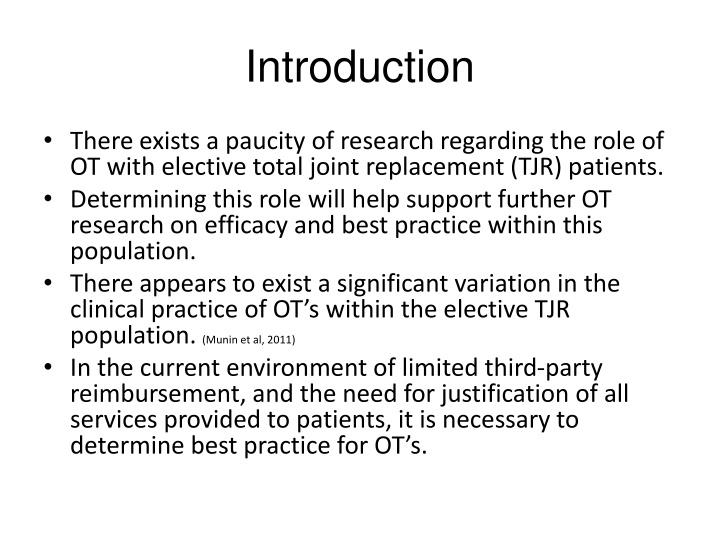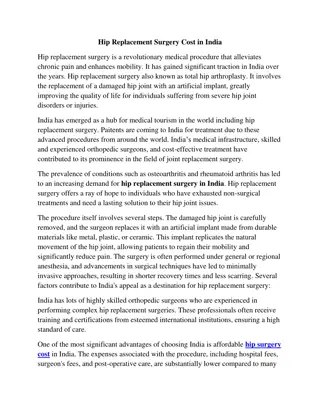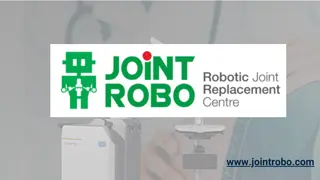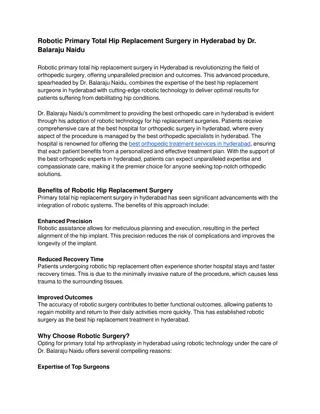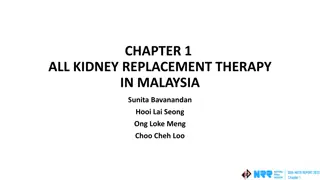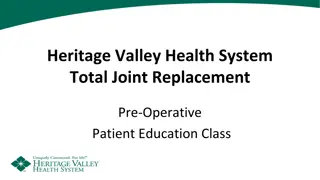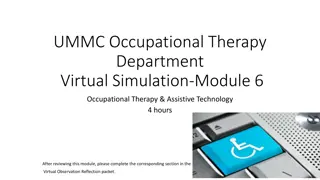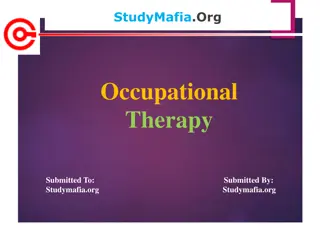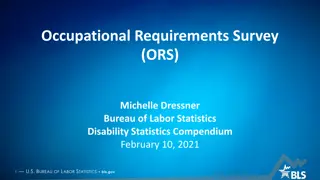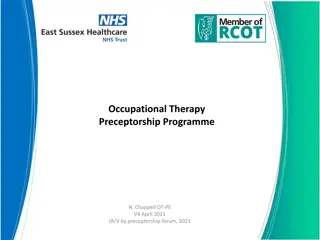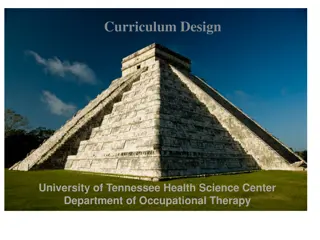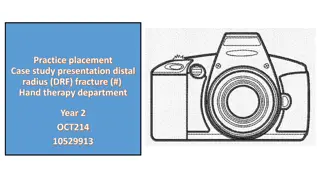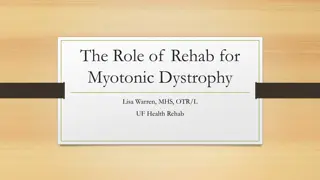Role of Occupational Therapy in Elective Total Joint Replacement: A Literature Review
Limited research exists on occupational therapy (OT) with elective total joint replacement (TJR) patients, highlighting the need to establish best practices and efficacy. Variability in OT clinical practices for TJR patients necessitates a standardized approach. Existing literature discusses the impact of TJR, evidence for OT interventions, and the importance of holistic, patient-centered care during the post-operative period.
Uploaded on Sep 12, 2024 | 3 Views
Download Presentation

Please find below an Image/Link to download the presentation.
The content on the website is provided AS IS for your information and personal use only. It may not be sold, licensed, or shared on other websites without obtaining consent from the author.If you encounter any issues during the download, it is possible that the publisher has removed the file from their server.
You are allowed to download the files provided on this website for personal or commercial use, subject to the condition that they are used lawfully. All files are the property of their respective owners.
The content on the website is provided AS IS for your information and personal use only. It may not be sold, licensed, or shared on other websites without obtaining consent from the author.
E N D
Presentation Transcript
Introduction There exists a paucity of research regarding the role of OT with elective total joint replacement (TJR) patients. Determining this role will help support further OT research on efficacy and best practice within this population. There appears to exist a significant variation in the clinical practice of OT s within the elective TJR population. (Munin et al, 2011) In the current environment of limited third-party reimbursement, and the need for justification of all services provided to patients, it is necessary to determine best practice for OT s.
Literature Review: Impact of TJR 2010: 719,000 total knee replacements (TKR) 332,000 total hip replacements (THR) (Centers for Disease Control and Prevention, 2010). 2009: 75% of TJR patients received some form of post-acute rehab: home-based therapy skilled nursing facility, acute/intensive inpatient rehabilitation program (Dejong et al, 2009). Average hospital LOS for THR in the USA: 1980 s: 3 weeks (Epstein et al, 1987) 2005: 4 days (Herbold et al, 2011)
Literature Review Meta-analysis of data determined only weak evidence supports the benefits of OT intervention for elective THR patients (College of Occupational Therapists: Specialist Section, Trauma and Orthopaedics, 2012). Evidence supports the involvement of OT s during the pre-op educational process (Couteyre et al, 2007). Research suggests criteria for d/c from the hospital include that patients: Are able to perform self-care, including med-management Are able to understand the signs and symptoms indicating return to the hospital Are able to perform ADL s with minimal assistance Research does not report who determines whether or not these goals are met. (Raphael et al, 2011)
Literature Review Study of elective TJR patients in Norway revealed that rehab there typically included PT and medical interventions by a doctor, but not always OT or social services interventions It was found that patients reported un- addressed difficulties with activities of daily living and home-related activities (Grotle et al, 2010).
Literature review Assessment of psycho-emotional factors in an elective TJR program revealed that an emphasis on positive feedback was correlated with positive outcomes. (Stavrev & Ilieva, 2003) OT s are poised to provide holistic, functional, patient- centered, and occupation-based interventions that are presumed to have a positive impact on overall success following elective TJR. Given that the greatest declines in strength/functional performance occur in the immediate post-op period, it can be deduced that OT s should have evidence to guide their practice during this essential time. (Bade & Stevens-Lapley, 2012)
Problem Statement/Purpose The OT field lacks participation in tracking outcomes of ADL and IADL performance in the TJR population; when in fact, OT s would be the most qualified healthcare professionals to determine success in these goals. Lack of research in this area may put OT in danger of being phased out of elective TJR programs. This preliminary study seeks to determine the most recent trends in OT assessment, intervention, and pt education, prior to efficacy research being performed.
Objectives Demographically describe OT s treating TJR patients. Calculate the frequency of use of standardized programs/protocol/clinical pathways. Determine OT s current role in the pre-operative education process. Ascertain time spent on various treatment activities from therapists perspectives. Clarify AE commonly recommended or issued. Determine use of standardized assessments and outcome measurements. Summarize common discharge setting recommendations among OT s.
Methodology Subjects: OT s/COTA s working in acute care (including full-time, part-time, prn). Instrumentation: Survey was created by the researcher and reviewed by several other OT s, then revised. Data Collection: Online via email, social media (twitter, fb, etc), anonymous via web-link. Data analysis: Descriptive statistics was used to determine trends.
Preliminary Results: Demographics Collection of results is ongoing. Survey has been posted online for 1 week. N=10 9 OT s, 1 COTA 4 Full-time, 4 Part-time, 2 PRN Of these, 8 had worked at some point in another treatment setting (SNF, outpatient, home health, peds, mental health, or inpatient rehab).
Preliminary Results: Demographics 2 to 5 Years in OT Years in Acute Care 6 to 10 11 to 15 16 to 20 1 20+ 2 2 2 to 5 6 to 10 3 1 11 to 15 6 2 3
Preliminary Results: TJR Program Characteristics 6 therapists worked at hospitals that have a standardized TJR program/protocol/pathway. All had pre-op education classes. The pre-op education class was mandatory for 4. No pre-op education classes had OT involvement. No therapists reported the use of standardized assessments. 2 worked in settings that tracked outcomes to measure the success of the TJR program.
Preliminary Results: Eval & Treatment Activities All respondents reported they receive OT orders for all TKR, anterior THR, and posterior THR patients. Treatment Activities: See Tables.
Equipment Recommendations Percent of OT depts that issued/recommended certain AE/DME as standard to ALL patients: TKR: 30% 100%: elevated toilet seat, shower chair/tub bench, reacher, sock aid, long sponge, long shoehorn 60%: 3-1 commode, dressing stick Anterior THR: 50% 100%: elevated toilet seat, shower chair/tub bench 25%: 3-1 commode, reacher, sock aid, long sponge, long shoehorn, dressing stick Posterior THR: 100% 100%: Reacher, Sock aid 80%: 3-1 Commode, Shower chair/tub bench, long sponge 60%: elevated toilet seat, long shoehorn 30%: dressing stick 20%: leg lifter, elastic laces
Equipment Recommendations Percent of respondents that personally issued/recommend certain AE/DME as standard to ALL patients: TKR: 30% 100%: Shower chair/tub bench, reacher 66%: elevated toilet seat, sock aid, long sponge, long shoehorn Anterior THR: 70% 71%: elevated toilet seat, shower chair/tub bench, reacher, sock aid 57%: 3-1 commode, long sponge, long shoehorn 28%: dressing stick Posterior THR: 80% 100%: Reacher, sock aid 75%: 3-1 commode, elevated toilet seat, shower chair/tub bench, long handle sponge 62%: long shoehorn 38%: leg lifter, dressing stick 25%: elastic laces
Discharge Recommendations: TKR 90% 80% 70% 60% Home without OT f/u 50% 40% Home with HHOT 30% 20% SNF/Sub-acute rehab 10% Acute/Inpatient rehab 0% None 1 to 25% 26 to 50% 51 to 75% 76 to 100%
Discharge Recommendations: Ant THR 70 Home without OT f/u 60 50 Home with HHOT 40 SNF/Sub-acute rehab 30 20 Acute/Inpatient rehab 10 0 None 1 to 25% 26 to 50% 51 to 75% 76 to 100%
Discharge Recommendations: Post THR 120 100 80 Home without OT f/u Home with HHOT 60 SNF/Sub-acute rehab Acute/Inpatient rehab 40 20 0 None 1 to 25% 26 to 50% 51 to 75% 76 to 100%
Discussion A Majority of respondents were OT s, and either full- or part-time employees. There was a diversity of experience levels. A majority of respondents has worked in practice settings other than acute care. Slightly more than half had standardized protocols/pathways for elective TJR patients. All provided pre-op education, but none involved OT. None used standardized assessments, and few tracked outcomes to determine the success of their program.
Discussion Respondents spent more time on ADL s and transfers, than on ambulation. No time was spent on exercise for any populations. OT depts issued or recommended certain equipment as standard to all posterior THR patients, but only some anterior THR and TKR patients. OT s personally recommended more equipment to THR patients than TKR patients.
Discussion OT s more commonly recommended home health OT or rehab in a skilled nursing facility for THR patients (anterior and posterior) than for TKR patients. Patients frequently discharged home without a recommendation for follow-up from OT afterward.
Conclusion These results are preliminary, from a very small sample size. Data collection and analysis is ongoing. Interpretation of these results is guarded. OT s commonly focus on ADL s and transfers in the immediate post-op period. A diversity of clinical judgment exists in determining the need for adapted equipment. A large amount of patients discharge home without further follow-up from OT. Further research is required to determine efficacy and best practice for OT in the immediate post-op period following elective TJR.
References American Occupational Therapy Association. (2002). Occupational Therapy Practice Framework: Domain and Process. American Journal of Occupational Therapy, 56, 609-39. Bade, M.J. & Stevens-Lapley, J.E. (2012) Restoration of Physical Function in Patients Following Total Knee Arthroplasty: An Update on Rehabilitation Practices. Current Opinion in Rheumatology, 24:2. Centers for Disease Control and Prevention. (2010). National Hospital Discharge Survey: 2010 table, Procedures by selected patient characteristics - Number by procedure category and age. Retrieved July 15, 2014, from http://www.cdc.gov/nchs/fastats/inpatient-surgery.htm. College of Occupational Therapists: Specialist Section, Trauma and Orthopaedics. (2012). Occupational Therapy for Adults Undergoing Total Hip Replacement: Practice Guideline. College of Occupational Therapists Ltd: London. Couteyre, E., Jardin, C., Givron, P., Ribinik, P., Revel, M. & Rannou, F. (2007). Could Preoperative Rehabilitation Modify Post-Operative Outcomes After Total Hip and Knee Arthroplasty? Elaboration of French Clinical Practice Guidelines. Annales De Readpatation Et De Medecine Physique, 50, 189- 97. Drummond, A., Coole, C., Brewin, C. & Sinclair, E. (2012). Hip Precautions Following Primary Total Hip Replacement: A National Survey of Current Occupational Therapy Practice. British Journal of Occupational Therapy, 75, 164-70. Drummond, A., Edwards, C., Coole, C. & Brewin, C. (2013). What Do We Tell Patients About Elective Total Hip Replacement in the United Kingdom? An Analysis of Patient Literature. Biomed Central Musculoskeletal Disorders, 14:152-58. Dejong, G., Hieh, C., Gassaway, J., Horn, S., Smout, R., Putman, K., James, R., Brown, M., Newman, E. & Foley, M. (2009). Characterizing Rehabilitation Services for Patients with Knee and Hip Replacement in Skilled Nursing Facilities and Inpatient Rehabilitation Facilities. Archives of Physical Medicine & Rehabilitation, 90, 1269-83.
References Epstein, A.M., Read, J.L. & Hoefer, M. (1987). The Relation of Body Weight to Length of Stay and Charges for Hospital Services for Patients Undergoing Elective Surgery: A Study of Two Procedures. American Journal of Public Health, 77, 993-8. Grotle, M., Garratt, A.M., Klokkerud, M., Lochting, I., Uhlig, T., Hagen, K.B. (2010). What s in Team Rehabilitation Care After Arthroplasty for Osteoarthritis? Results from a Multicenter, Longitudinal Study Assessing Structure, Process, and Outcome. Physical Therapy, 90, 121 31. Herbold, J.A., Bonistall, K. & Walsh, M.B. (2011). Rehabilitation Following Total Knee Replacement, Total Hip Replacement, and Hip Fracture: A Case-Controlled Comparison. Journal of Geriatric Physical Therapy, 34, 155-60. Keifer, D.E. & Emery, L.J. (2004). Functional Performance and Grip Strength After Total Hip Replacement. Occupational Therapy in Healthcare, 18, 41-56. Keith, R. (1997). Treatment Strength in Rehabilitation. Archives of Physical Medicine & Rehabilitation, 78, 1298-304. Kersten, R.F.M.R., Martin, S., Van Raay, J.J.A.M., Bulstra, S.K. & Van Den Akker- Scheek, I. (2012). Habitual Physical Activity After Total Knee Replacement. Physical Therapy, 92, 1109-16. Khan, F., Ng, L., Gonzalez, S., Hale, T. & Turner-Stokes, L. (2008). Multidisciplinary Rehabilitation Programmes Following Joint Replacement at the Hip and Knee in Chronic Arthropathy. Cochrane Database Systematic Reviews, 2:1-51. Kim, S., Losina, E., Solomon, D.H., Wright, J., Katz, J.N. (2003). Effectiveness of Clinical Pathways for Total Knee and Total Hip Arthroplasty: A Literature Review. The Journal of Arthroplasty, 18, 69-74.
References McDonald, S., Hetrick, S.E. & Green, S. (2004). Pre-Operative Education for Hip or Knee Replacement. Retrieved July 10, 2014, from http://onlinelibrary.wiley.com/doi/10.1002/14651858.CD003526.pub2/full Munin, M.C., Putman, K., Hsieh, C.H., Smout, R.J., Tian, W., Dejong, G. & Horn, S.D. (2010). Analysis of Rehabilitation Activities within Skilled Nursing and Inpatient Rehabilitation Facilities After Hip Replacement for Acute Hip Fracture. American Journal of Physical Medicine & Rehabilitation, 89, 530-40. Oganda, L., Wilson, R., Archbold, P., Lawler, M., Humphreys, P., O Brien, S. & Beverland, D. (2002). A Minimal-Incision Technique in Total Hip Arthroplasty Does Not Improve Early Postoperative Outcomes. Journal of Bone Joint Surgery, 87:701- 10. Raphael, M., Jaeger, M. & Van Vlymen, J. (2011). Easily Adoptable Total Joint Arthroplasty Program Allows Discharge Home in Two Days. Canadian Journal of Anesthesiology, 58, 902-10. Stavrev, V.P. & Ilieva, E.M. (2003) The Holistic Approach to Rehabilitation of Patients After Total Hip Joint Replacement. Folia Medica, 45. Thomas, W.N., Pinkelman, L.A., Gardine, C.J. (2010). The Reasons for Noncompliance with Adaptive Equipment in Patients Returning Home After a Total Hip Replacement. Physical & Occupational Therapy in Geriatrics, 28, 170-80. Tian, W., Dejong, G., Brown, M., Hseih, J. & Zamfirov, Z. (2009). Looking Upstream: Factors Shaping the Demand for Post-Acute Joint Replacement Rehabilitation. Archives of Physical Medicine & Rehabilitation, 90, 1260-8
